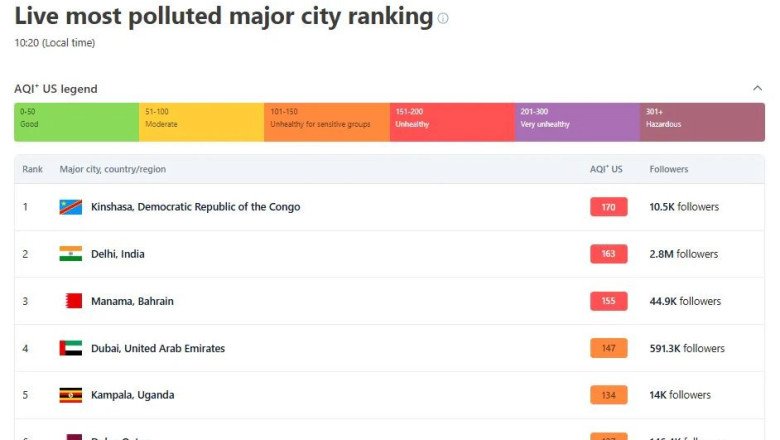
views
Air Pollution in Dubai: Is the City’s Glittering Skyline Hiding a Secret?
Dubai dazzles the world with its futuristic skyscrapers, luxury resorts, and record-breaking ambitions. But on August 27, 2025, at 10:30 PM PT, the metropolis found itself in the spotlight for a different reason: it was ranked the fourth most polluted major city in the world.
The air outside was not just hazy—it was dangerous. Monitors classified conditions as “unhealthy for sensitive groups,” with fine dust and emissions swirling through the streets. For a city that markets itself as a global hub for innovation, the question became unavoidable: is the air in Dubai really safe to breathe?
A Bad Night in the Desert
That evening, a cocktail of desert dust and urban emissions blanketed Dubai, Abu Dhabi, and Sharjah. The culprit was PM2.5—tiny invisible particles small enough to slip past the body’s defenses, lodging deep in the lungs and even entering the bloodstream.
Doctors warned that for children, the elderly, and anyone with asthma or heart disease, the risk was immediate: coughing fits, shortness of breath, even an increased chance of heart attacks. For the rest of us? Silent damage that builds up over time.
Residents were told to seal their windows, stay inside, and keep the air purifiers running. Yet, even indoors, the knowledge lingered: the city’s glamorous lifestyle can’t always protect you from the air you breathe.
Dubai’s Average Day: Not as Clean as You Think
It’s tempting to dismiss that night as an anomaly. But here’s the unsettling truth: average air pollution in Dubai is far from clean.
In 2024, the city’s average PM2.5 concentration was 33.5 µg/m³, giving it an AQI score of 97—“moderate,” but still 6.7 times higher than the World Health Organization’s safe limit. Translation? Even on a so-called normal day, residents inhale enough fine particles to slowly strain their lungs and hearts.
Dubai might not always top the global pollution charts, but its average air still poses long-term health risks.
The Hidden Culprits Behind Air Pollution in Dubai
Why is a city built in the middle of a desert struggling with its air? The answer is both natural and man-made.
Dust Storms: Every year, winds whip across the Arabian desert, carrying fine sand that turns the sky orange and sends AQI numbers soaring. It’s nature’s contribution to pollution—and there’s little escape.
Cars, Cars, Cars: Dubai’s love affair with private vehicles means traffic is a daily smog factory. Despite an expanding metro system, nitrogen oxides and black carbon from cars dominate the skyline just as much as the Burj Khalifa.
Construction Dust: A city that builds nonstop is also a city that constantly stirs up fine dust. Mega-projects bring luxury, but they also add layers of particulate matter to the air.
Fossil Fuels: Power plants, desalination, and heavy industry—all still tied to oil and gas—release sulfur dioxide and nitrogen oxides into the atmosphere.
Together, these factors make air pollution in Dubai an ever-present challenge, one that lingers even when the dust storms pass.
When Will the Air Clear?
Here’s the frustrating part: air quality in Dubai can change by the hour. A shift in wind may clear the skies for a day, giving residents a taste of relief. But just as quickly, pollutants creep back.
Long-term solutions require more than lucky weather. Experts say the city must:
Until those measures take hold, residents are stuck watching the AQI like a weather forecast, planning their lives around invisible risks.
How Air Pollution in Dubai Shapes Daily Life
Air pollution isn’t just a statistic; it’s a lived experience. Parents check air-quality apps before letting children play outside. Runners swap the beach track for the treadmill. Schools postpone sports events. And in luxury apartments, air purifiers hum as a new kind of background noise.
Masks—once associated with pandemics—are making a comeback for a different reason: protection against pollution in Dubai. For a city that prides itself on health, leisure, and modern living, this new accessory tells a sobering story.
The Road Ahead: A Cleaner Dubai?
Dubai has proven it can reinvent itself: from fishing village to global hub in a few short decades. Now the challenge is to reinvent its relationship with the air. The city is already investing in solar power, electric buses, and sustainability-driven urban planning. If these projects succeed, Dubai could flip the script and become a model for clean living in the desert.
But until then, the question lingers: can a city so focused on shining towers and luxury lifestyles confront the invisible enemy in the air?
So, is the air quality good in Dubai? Sometimes. But air pollution in Dubai is a constant undercurrent—shaped by sandstorms, exhaust pipes, and construction cranes. The August 27 episode was more than a bad-air day; it was a reminder that even the world’s most glittering cities cannot escape the simple truth: the air we breathe matters more than any skyline.
https://www.dubaichronicle.com/2025/08/28/the-unseen-threat-air-pollution-in-dubai/

























Comments
0 comment